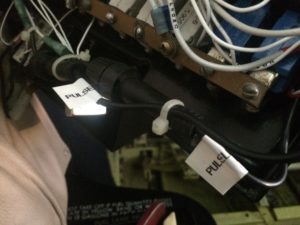Podcast: Play in new window | Download
Episode #030… thanks Cliff Ravenscraft for all the excellent instruction in the course Podcasting A to Z! That’s how I was even able to get this thing off the ground!
And, if YOU have a reason to start a podcast, check out Cliff’s course… it is top-notch! For more information, check out PodcastingAtoZ.com
In today’s episode, I’m telling th e story about troubleshooting a Precise Flight Pulselite system in an A36 Bonanza. It was not working when the airplane came in for the annual inspection, and it took some digging to determine what was wrong and fix it.
e story about troubleshooting a Precise Flight Pulselite system in an A36 Bonanza. It was not working when the airplane came in for the annual inspection, and it took some digging to determine what was wrong and fix it.
It was worth it though… I’m a firm believer in pulsing landing lights, for the increased visibility they provide to other aircraft.
Locating the Pulselite control was a key part of the troubleshooting process.

 Finding the unmarked fuse holders for the Pulselite system was quite challenging… they were behind the circuit breaker panel on the pilot’s sidewall.
Finding the unmarked fuse holders for the Pulselite system was quite challenging… they were behind the circuit breaker panel on the pilot’s sidewall.
Turns out, the 20 amp fuse was blown! Check out the picture of the blown fuse, along with a new one to replace it.
Hopefully, labeling these fuseholders and putting a placard next to the Pulselite control, may help someone in the future, if there is ever another similar problem with this system.
In situations like these, sometimes it may be helpful to have the installation records and 337 form for a modification like this. So I wanted to mention that you can get a CD of these kinds of records from the FAA Certification Office for a very small fee… just $10! If your 337 forms and records are scattered or incomplete, this may be something to look into.
As I think back on this whole scenario now, it reminded me of some things that airplane owners can do, to make the troubleshooting process more efficient for their mechanics, especially if it is an added piece of equipment, that may not have any information in the aircraft maintenance manual.
- You can order a copy of your aircraft records from the FAA Certification Office. You can get a CD for $10, that will include all the 337 forms that have been filed for your airplane. This is an amazing resource! Keep this information available to your mechanic, especially during annual inspection.
- Whenever possible, make sure all your fuse holders are labeled, both for the component they are powering, and the proper amperage of the fuse.
- Add a listing of all these fuse holders, and their location, and the proper amperage of the fuse, in your POH or owner’s manual. (Perhaps in the section for the electrical system.)
- When having modifications done to your airplane, ask questions about all this, and make a plan to ensure all these details are covered. You’ll be glad you did if…
- Whenever you encounter a problem like the one I described today, go ahead and label things at that time, if not already done.(I put a placard next to the Pulselite control, indicating that there were 2 fuses for this system behind the pilot’s circuit breaker panel.)





Leave a Reply
You must be logged in to post a comment.